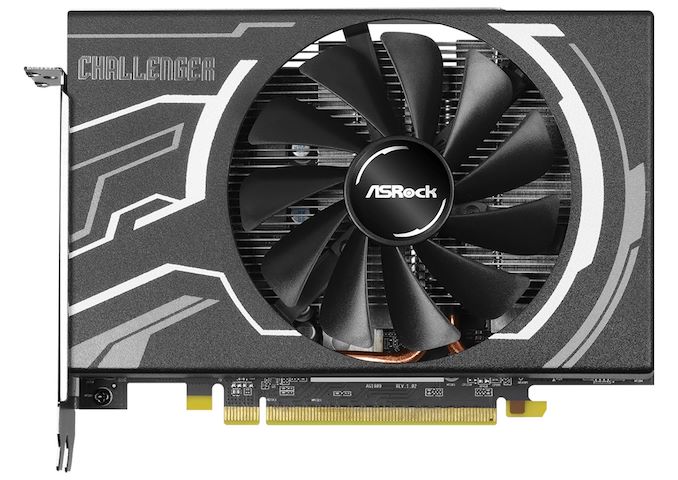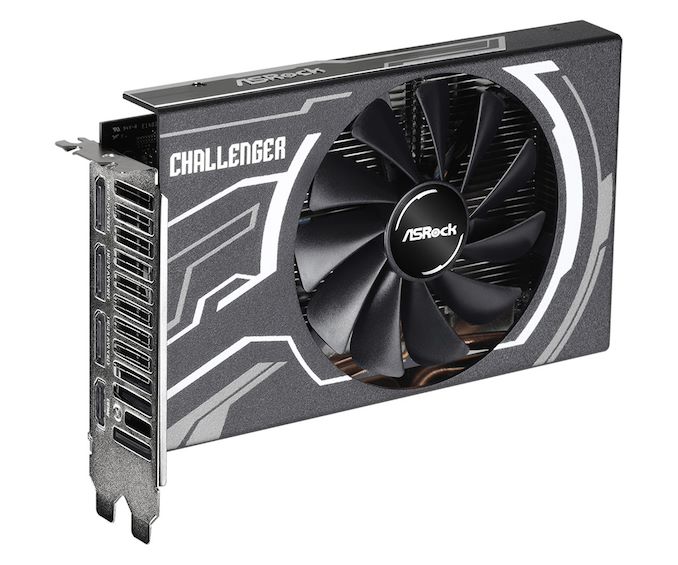ASRock Unveils Radeon RX 5500 XT Challenger ITX 8 GB Graphics Card
by Gavin Bonshor on April 16, 2020 2:00 PM EST- Posted in
- GPUs
- Radeon
- ASRock
- Mini ITX
- Navi
- 7nm
- RX 5500 XT
- Challenger ITX
 jpg_678x452.jpg)
ASRock has announced its latest ITX graphics card for small form factors, the Radeon RX 5500 XT Challenger ITX. This new mini-ITX card is based on AMD's Navi 14 GPU and offers 8 GB of GDDR6 memory attached to a 128-bit bus, with the same core and memory clock speeds as a reference model.
Finding a graphics card for a small form factor system can be tiresome with very little on the market to choose from. One of the big trade-offs of graphics cards designed for small form factor systems is that beefier models such as AMD's RX 5700 XT, and NVIDIA's GeForce RTX 2080 Ti are too large in design to accommodate such a small PCB, which is where smaller cards designed particularly for the ITX form factor come in.
Focusing on the ASRock RX 5500 XT Challenger ITX 8G, it is very small for its power with dimensions of 190 x 139 x 42 mm, meaning that it is just under 7.5 inches in length. It features a single 10 cm cooling fan on its front, embedded in a white and silver dual-slot cooler, which is designed to direct hot air out of the rear of a chassis. The cooler on the ASRock RX 5500 XT Challenger ITX 8 G is actually longer than a reference model (7.5 vs 7.1 inches) but is still much smaller than most aftermarket designs from other vendors.
Physical size aside, the card is very similar in specifications to other 5500 XT cards on the market. The Challenger ITX ships with a base core clock of 1607 MHz and acn boosts up to 1845 MHz. Meanwhile the effective memory core clock speed of 14 Gbps. Unsurprisingly then, with its reference-like clocks, the card is targeted towards 1080p gaming.
As for display outputs, ASRock has outfitted the card a trio of DisplayPort 1.4 connectors as well as a single HDMI 2.0b port. Feeding the mini monster is a single 8-pin 12 V ATX PCIe power connector, which is more than sufficient to meet its 130 W TDP.
ASRock hasn't announced when the Radeon RX 5500 XT Challenger 8G will be available at retailers, nor has it provided any information about its price.
Related Reading
- The AMD Radeon RX 5500 XT Review, Feat. Sapphire Pulse: Navi For 1080p
- ASUS Launches An Old GPU: The NVIDIA GT710 with Four 4K HDMI Ports
- EVGA Announces GeForce RTX 2070 Super KO & RTX 2080 Super KO
- NVIDIA's GeForce GTX 1650 GDDR6 Released: GDDR6 Reaching Price Parity With GDDR5
- PowerColor Extends Product Warranty by Three Months Due to Coronavirus
Source: ASRock












62 Comments
View All Comments
wr3zzz - Thursday, April 16, 2020 - link
I don't understand why ITX has gotten so much more popular than mATX in the DIY market. You are limited to the very low end of discrete graphics cards. If space is really that big a deal, you should get a notebook which is far more functional with arguably more performance potential. mATX has the full functionality of real desktop in a small package.I can understand the appeal of ITX for corporate customers, but not for DIY.
edzieba - Thursday, April 16, 2020 - link
You clearly have not been paying attention to SFF systems for the past decade. A 12L Dan A4 (no cheating with external PSUs) will quite happily host a full-length 2080Ti plus a 9900k with a suitable cooler (low-profile 120mm), and there is a massive choice of cases in the sub-20L range that all take full-size GPUs and often WC loops. And all will beat the pants off a laptop for a fraction of the cost.Unless you have more than 1 PCIe slot populated (an uncommon situation for most boxes) mATX is just a bloated board for no functional gain. As is ATX for that matter.
Valantar - Friday, April 17, 2020 - link
Completely agree. Saying laptops have "arguably more performance potential" just shows that the OP here has zero idea of what SFF builders do. Though you have the volume for the A4 all wrong - it's 7.2l. Were you thinking of the Ncase M1? Either way, the selection of good cases below 20l is _huge_, and even below 10l there is quite a decent amount these days. Saying mATX is better than ITX just shows that this person only knows of mainstream ITX cases which are almost universally poorly optimized for space (like the NZXT H200 series).I completely agree that mATX has great value (it provides pretty much everything ATX does in a smaller size), but saying ITX limits you to very low end discrete cards .... no. Not even close. Heck, check out the Not From Concentrate site/youtube channel for their S4 Mini 2080Ti builds, and you suddenly see what's possible.
lenghui - Tuesday, April 21, 2020 - link
I too have a NZXT H200 mini-ITX case and I love it. However, I think user wr3zzz is just asking a valid question politely, no need to be OC (overly-critical).Valantar - Tuesday, April 21, 2020 - link
Is pointing out the factual errors in the original post being "overly critical"? The question was based on a series of entirely false assumptions (ITX builds being incapable of housing high end hardware, laptops being more functional and having more "performance potential" whatever that means), so responding to the question would be both disingenuous and pointless. Correcting the false assumptions should on the other hand demonstrate why the question is wrong and why ITX is growing in popularity.krazyfrog - Wednesday, April 22, 2020 - link
I see no question. Only judgement.jtd871 - Friday, April 17, 2020 - link
DAN A4 is 7L.Brane2 - Saturday, April 18, 2020 - link
Which can't be reasonably cooled within that form-factor.mini-ITX is good enough for an APU, perhaps with low-profile extra card, like 10G Ethernet or something.
bananaforscale - Saturday, April 18, 2020 - link
Actually, you're demonstrably wrong. All it takes is engineering.Reflex - Sunday, April 19, 2020 - link
Noctua does a fine job. The Dan A4-SFX also supports water cooling if that is your thing, all in a 7.2L case.